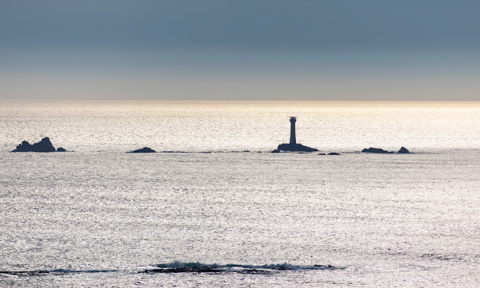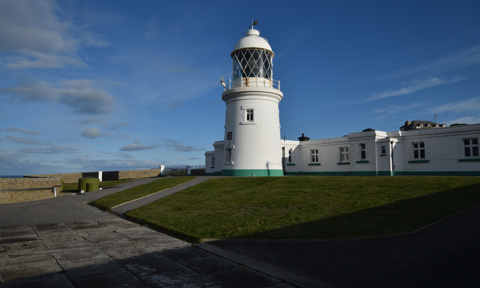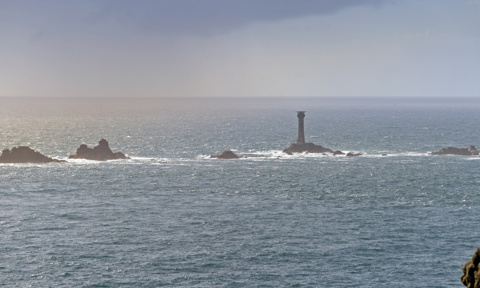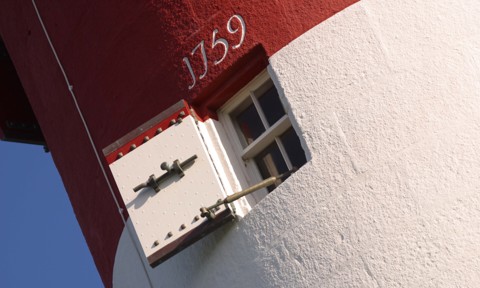
Eddystone
50°10′48″N 04°15′54″W
13nm SW from Plymouth. View on a map
Visible from Plymouth on a clear day, there have been 4 lighthouses on this Eddystone rock, the 1st lighthouse built by Henry Winstanley in 1698 and was made of wood, and didn’t look like the lighthouses you’d see today. During building he was captured by a privateer and taken to France and then quickly released by Louis XIV who declared "France is at War with England, not with Humanity!" such was the importance of marking the Eddystone Rocks. Winstanley was killed in the lighthouse when it was destroyed in a storm.
The second ‘Rudyard’ lighthouse built in 1755 was of a more traditional style, but unfortunately destroyed by fire. The third ‘Smeaton’ lighthouse was a step-up, incorporating stronger building techniques, however the structure slowly began to weaken and it was dismantled and re-constructed on Plymouth Hoe as a monument and museum. The current ‘Douglass’ lighthouse has stood the test of time, first lit in 1882. The base of Smeaton’s lighthouse can still be seen on the rocks.
Image credit Pline

Wolf Rock
49°56.72′N 05°48.50′W
8nm off Land's End. View on a map
The rock here was originally marked by daymarks and beacons, they were all washed away except for the present beacon which still stands next to the lighthouse. The current light was constructed in 1869, with a design based on Bishop Rock Lighthouse. First lit in 1870, the optic was rotated by a clockwork drive which needed winding every four hours and it was the first lighthouse to be fitted with a helipad in 1972!
Image credit Trinity House

Longships
50°4′00.69″N 5°44′48.39″W
Off Land's End. View on a map
The first light at Longships was built in 1795, and was 24m high. High seas often obscured the light, so the current taller replacement was built and first lit in 1873. It had a fixed white light and two red sectors; but even with these improvements the 'SS Bluejacket' nearly destroyed the tower when wrecked on the rocks in 1898. Bad weather often delayed crew reliefs and in 1901 the crew ran out of tobacco, and tried to smoke coffee, hops and tea leaves instead!
The light is now fully automatic so this isn’t a problem these days.

Pedeen
50.164983°N 5.671526°W
Pendeen, near Penzance, Cornwall. View on a map
Lighthouses on the mainland often come equipped with much better facilities such as cottages for full families, such as at Pendeen Lighthouse further up the Cornish coast; built on a specially flattened headland, it was the first Trinity House Light to be fitted with an incandescent bulb. This meant that the whole facility now only needed one keeper to tend to the light and fog signal, which was housed atop a separate engine room and formally required an extra keeper. First lit in 1900, it was automated in 1995, which is quite a few years later than many other lighthouses.

Smeaton's Tower
50°21'51.6"N 04°08'30.9"W
Plymouth Hoe, Devon. View on a map
How could we write an article about Westcountry lighthouses without talking about Smeaton's Tower?
Named after civil engineer John Smeaton who designed the third Eddystone lighthouse that still stands today, Smeaton's Tower was originally built on Eddystone reef in 1759. However, in the late 1800s, engineers discovered the rock was unstable so efforts began to move the lighthouse, stone-by-stone, to Plymouth Hoe.
The bottom third of the tower remains on Eddystone rocks and is visible next to the lighthouse, but the upper two thirds stand proudly on Plymouth Hoe as the most recognisable feature in Plymouth's skyline.

Bishop Rock
49°52′22.5″N 06°26′44.5″W
4nm west of the Isles of Scilly. View on a map
Lastly one other lighthouse many of us enjoy to see is Bishop Rock lighthouse. Known as the ‘King of the Lighthouses’ it stands 49m tall. The current lighthouse is the second attempt to build, as the first attempt initially failed. Facing the full force of the Atlantic, vibrations through the building during heavy weather often knocked items off shelves and broke the optical apparatus. To prevent this, the tower was reinforced by granite blocks, raising the structure by 12m! Often the first thing to be seen over the horizon when returning from a transatlantic crossing, it’s a welcome and impressive sight for any seafarer!
Image credit: cc-by-sa/2.0 - © Richard Knights - geograph.org.uk/p/31517
Find the Westcountry's Lighthouses
Marina Berthing in Plymouth
Whether you're passing through as part of a longer trip, or you're looking for a permanent berth for your boat, Plymouth Yacht Haven offers a warm welcome and sheltered marina berthing.




